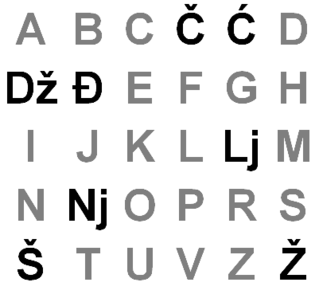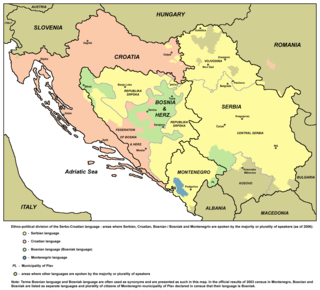 W
W}}
 W
WGaj's Latin alphabet is the form of the Latin script used for writing Serbo-Croatian and all of its standard varieties: Bosnian, Croatian, Serbian, and Montenegrin.
 W
WThe grapheme Čč is used in various contexts, usually denoting the voiceless postalveolar affricate consonant like the English ch in the word chocolate. It is represented in Unicode as U+010C and U+010D.
 W
WStandard Bosnian, Croatian, Montenegrin, and Serbian are different national variants and official registers of the pluricentric Serbo-Croatian language.
 W
WCroatian Encyclopedic Dictionary is a dictionary of Croatian published in 2002 as one volume edition by the publisher Novi Liber. Second edition of the dictionary in 12 volumes was published in 2004 by the Novi Libar and Hanza Media. Chief editors of the dictionary are Ljiljana Jojić and Ranko Matasović, while the authors are Vladimir Anić, Dunja Brozović-Rončević, Ivo Goldstein, Slavko Goldstein and Ivo Pranjković. In addition, there are twenty-three associates.
 W
WCroatian Glagolitic or Croatian Glagolitic Script is a version of Glagolitic used in Croatia.
 W
WCroatian Writers' Association is the official association of Croatian writers. It was founded in 1900 in Zagreb with the goal "to unite writers and help them support one another, and promote Croatian literature regardless of political objectives", "to protect the interests and increase the reputation of writers" and "supports its members and their orphans." The DHK's president is Zlatko Krilić, while Boris Domagoj Biletić and Mirko Ćurić are vice-presidents.
 W
WThe Declaration on the Common Language was issued in 2017 by a group of intellectuals and NGOs from Croatia, Bosnia and Herzegovina, Montenegro, and Serbia who were working under the banner of a project called "Language and Nationalism". The Declaration states that Croats, Bosniaks, Serbs and Montenegrins have a common standard language of the polycentric type.
 W
WThe Declaration on the Name and Status of the Croatian Literary Language is the statement adopted by Croatian scholars in 1967 arguing for the equal treatment of the Serbian, Croatian, Slovene, and Macedonian language standards in Yugoslavia. Its demands were granted by the 1974 Yugoslav Constitution.
 W
WThe Dubrovnik subdialect is a subdialect of the Shtokavian dialect of Serbo-Croatian. It is spoken in the area of Dubrovnik and the littoral of the former Republic of Ragusa, from Janjina on the Pelješac peninsula to the Croatian border with Montenegro.
 W
WThe Eastern Herzegovinian dialect is the most widespread subdialect of the Shtokavian dialect of Serbo-Croatian, both by territory and the number of speakers. It is the dialectal basis for all modern literary Serbo-Croatian standards: Bosnian, Croatian, Serbian, and Montenegrin.
 W
WMatica hrvatska is the oldest independent, non-profit and non-governmental Croatian national institution. It was founded on February 2, 1842 by the Croatian Count Janko Drašković and other prominent members of the Illyrian movement during the Croatian National Revival (1835–1874). Its main goals are to promote Croatian national and cultural identity in the fields of art, science, spiritual creativity, economy and public life as well as to care for social development of Croatia.
 W
WThe Institute of Croatian Language and Linguistics is an official institute in Croatia whose purpose is to preserve and foster the Croatian language. It traces its history back to 1948, when it was part of the Yugoslav Academy of Sciences and Arts. The modern institute dates back to Croatia's independence in 1991.
 W
WLaw code of Vinodol or Vinodol statute is one of the oldest law texts written in the Chakavian dialect of Croatian and is among the oldest Slavic codes. It was written in the Glagolitic alphabet. It was originally compiled in 1288 by a commission of 42 members in Novi Vinodolski, a town on the Adriatic Sea coast in Croatia, located south of Crikvenica, Selce and Bribir and north of Senj. However, the code itself is preserved in a 16th-century copy.
 W
WThe Miroslav Krleža Institute of Lexicography is Croatia's national lexicographical institution. Based in Zagreb, it was originally established in 1950 as the national lexicographical institute of the Socialist Federal Republic of Yugoslavia. It was renamed after its founder, the Croatian writer Miroslav Krleža, in 1983.
 W
WThe Novi Sad Agreement was a document composed by 25 Serbian, Croatian and Bosnian writers, linguists and intellectuals to build unity across the ethnic and linguistic divisions within Yugoslavia, and to create the Serbo-Croatian language standard to be used throughout the country.
 W
WThe grapheme Š, š is used in various contexts representing the sh sound usually denoting the voiceless postalveolar fricative or similar voiceless retroflex fricative /ʂ/. In the International Phonetic Alphabet this sound is denoted with ʃ or ʂ, but the lowercase š is used in the Americanist phonetic notation, as well as in the Uralic Phonetic Alphabet. It represents the same sound as the Turkic letter Ş and the Romanian letter Ș (S-comma).